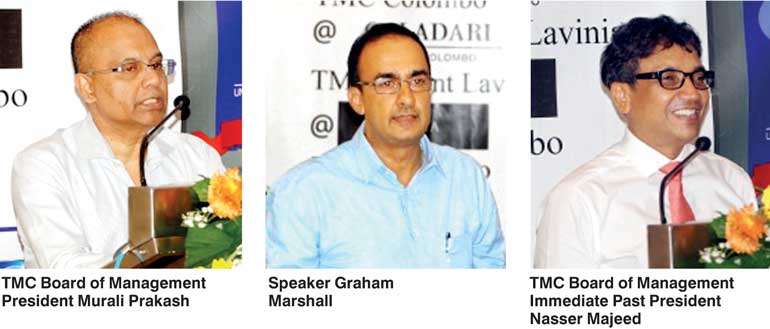Sunday Mar 16, 2025
Sunday Mar 16, 2025
Monday, 26 March 2018 00:00 - - {{hitsCtrl.values.hits}}
Addressing members and guests at The Management Club’s ‘Members Speak’ at the Galadari Hotel on 22 March, Graham Marshall in his unique style highlighted that building brand equity and improving profitability are often seen to be as two opposing corners of an organisation.
Sharing some thoughts, Graham stated that brands were most often taken for granted in good times and were the first to be penalised in bad times. He made it clear that strong brands are a route to strong business performance.

Building a brand is often perceived to be a very communication-skewed function at the end of the value chain, he said “the fun and glamour starts and ends here” is more like how the process is most perceived to be.
“What is a strong brand?” asked Graham. It is the ability to generate healthy cash flows and have the potential to do so in the future. This can only happen sustainably if market share keeps growing, thereby increasing its volumes.
Strong brands also have the ability to command a price premium. Scale advantages would kick in and profitability improves. Such a situation is only a consequence of the ability of the brand to build consumer/customer preference though a high degree of connect and relevance, built through careful nurturing.
How then is brand profitability managed and where does it fit into the process was the big question asked. Where are the drivers of brand profitability and who is responsible for it? Is it only the larger than life advertising budget that should be managed by brand teams?
Achieving targeted revenues at targeted contribution margin levels is what Graham stated was critical importance in building profitable brands. Creating market demand and building brands assets require large investment no doubt. This is to be supported by good commercial management of brands.
Contribution margin management was cited as an area of utmost importance. How does your product mix affect the margin of the business, how profitable are our customers? What is the impact of the promotions and rebates? Are incentives based on achievement of only revenue? What are the impact of obsolete stock and the importance of demand forecasting? These are all very much in the accountability and scope of marketing teams.
Graham cited a few case studies of local brands that have made huge inroads in market share and consumer connect. Ensuring organisations place principle over profit was stressed.
He wrapped up his speech by questioning: What is the brand’s carbon footprint? Can it be consciously and regularly reviewed and definite action taken to reduce it footprint and leave this world a better place for our future generations to live in?
A keen and interesting interaction followed his well-delivered presentation.
Pix by Ajit De Soyza of Theewra

Discover Kapruka, the leading online shopping platform in Sri Lanka, where you can conveniently send Gifts and Flowers to your loved ones for any event including Valentine ’s Day. Explore a wide range of popular Shopping Categories on Kapruka, including Toys, Groceries, Electronics, Birthday Cakes, Fruits, Chocolates, Flower Bouquets, Clothing, Watches, Lingerie, Gift Sets and Jewellery. Also if you’re interested in selling with Kapruka, Partner Central by Kapruka is the best solution to start with. Moreover, through Kapruka Global Shop, you can also enjoy the convenience of purchasing products from renowned platforms like Amazon and eBay and have them delivered to Sri Lanka.
Discover Kapruka, the leading online shopping platform in Sri Lanka, where you can conveniently send Gifts and Flowers to your loved ones for any event including Valentine ’s Day. Explore a wide range of popular Shopping Categories on Kapruka, including Toys, Groceries, Electronics, Birthday Cakes, Fruits, Chocolates, Flower Bouquets, Clothing, Watches, Lingerie, Gift Sets and Jewellery. Also if you’re interested in selling with Kapruka, Partner Central by Kapruka is the best solution to start with. Moreover, through Kapruka Global Shop, you can also enjoy the convenience of purchasing products from renowned platforms like Amazon and eBay and have them delivered to Sri Lanka.